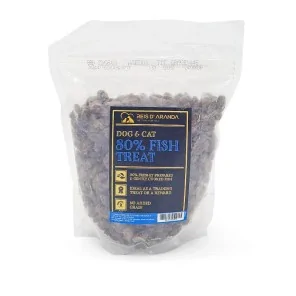The Tornjak originated from genetically homogeneous, almost extinct, indigenous shepherd dogs. These dogs have...
THE BEARDED COLLIE
INTRODUCTION
Bearded Collie fans agree that if you don't know this breed, you have to! Once you discover how this dog runs through the countryside with his wavy coat, the joy and energy with which he plays and, at the same time, how attentive he is to the wishes of his owners, it is not easy to forget the incomparable charm of this original breed.
THE ORIGIN OF THE BEARDED COLLIE
A breed similar to the Bearded Collie has been mentioned in Scottish records dating from around the 16th century. It has long been known in Scotland and the North of England, where it has been bred to herd sheep. About five hundred years ago, dogs, also said to be the ancestors of the Polish Lowland Sheepdog, were abandoned on the shores of Scotland and these were crossed with native sheepdogs.
In 1944, the breed was rediscovered by chance. At that time, the English dog breeder Mrs. G. O. Willison ordered a Shetland Sheepdog puppy and out of the basket she received came a brown and white puppy which the breeder at first considered to be a mongrel. Four months later, an old shepherd recognised the bearded collie in the supposedly mixed-breed puppy. Mrs. Willison was so excited about her new puppy, she helped bring the breed back. She searched tirelessly among British Shepherds for unique bearded collies with which to lay a new foundation for breeding. She passed on her enthusiasm for the rediscovered breed to other colleagues and encouraged them to join in the breeding of these dogs.
THE STANDARD OF THE BEARDED COLLIE
GENERAL APPEARANCE: Lean. Active dog. Although strongly built, should show plenty of light under body and should not look too heavy. Bright, inquisitive expression is a distinguishing feature.
IMPORTANT PROPORTIONS: Longer than high in approximately a ratio of 5 to 4 measured from point of chest to point of buttock. Females may be slightly longer.
The distance between the stop (naso-frontal depression) and the occiput should be equal to the distance between the ear holes.
HEAD: In proportion to size. The general effect is that of a dog with power of muzzle and plenty of room for the brain.
CRANIAL REGION:
SKULL: Broad, flat and square.
STOP: Moderate.
FACIAL REGION:
TRUFFLE: Large and square, usually black but normally in accordance with coat colour in blue and brown dogs. Nose should be solid in colour, without speckles or patches.
HOCOCO: Strong and of equal length to the distance between stop and occiput.
BELPHOS: Solid in colour without speckles or patches. The pigmentation is in accordance with that of the nose.
JAWS / TEETH: Teeth large and white. Strong jaws with perfect, regular and complete scissor bite is preferred, i.e. the upper incisors closely overlapping the lower incisors and set vertically in the jaws.
Pincer bite is tolerated but undesirable.
EYES: Matching coat colour, set wide apart and large, soft and affectionate, not prominent. The pigmentation of the eyelids is in accordance with that of the nose. Eyebrows arched upwards and forward but not so long as to hide the eyes.
EARS: Medium size and drooping. On alert, the ears are raised at their base, level with but not above the top of the skull, increasing in appearance the width of the skull.
NECK: Moderate length, muscular and slightly arched.
BODY: The length of the body is due to the length of the ribcage and not of the kidney area.
TOP LINE: Level.
LOIN: Strong.
CHEST: Deep, giving plenty of room for heart and lungs. Ribs well sprung but not barrel-shaped.
TAIL: Set on low, without knots or kinks and long enough for the last vertebra to reach the tibiotarsal joint. Carried low with an upward curve when the dog is at rest or in action, at speed it can be extended. Never carried over the back. Covered with abundant hair.
LIMBS
FOREQUARTERS:
GENERAL APPEARANCE: Legs straight and vertical with good bone structure, covered with bristly hair all around.
SCAPULAS: Sloping well backwards.
METACARPS: Flexible, without weakness.
HANDS: Oval; thick, strong and sound pads; toes arched and close together; well covered with hair even between the pads.
HIND LIMBS:
GENERAL APPEARANCE: Very muscular.
KNEES: Well angulated.
HINDQUARTERS: Good.
HINDQUARTERS: Low.
METATARS: The lower part of the lower leg falls at right angles to the ground and in normal position, just behind a vertical line below the ischium.
FEET: Oval, thick, strong and sound pads; toes arched and close together; well covered with hair even between the pads.
GAIT / MOVEMENT: Flexible, smooth and long reaching, covering ground with minimum effort.
COAT
HAIR: Double with soft, woolly, tight undercoat. The outer coat is smooth, harsh, strong and wiry, free from woolliness and curliness, although slight waves are permissible.
The length and density of the coat sufficient to provide a protective coat and to emphasise the silhouette of the dog, but not so much as to hide the lines of the body. The coat must not be groomed in any way. The muzzle sparsely covered with slightly longer hair on the sides to cover the lips. From the cheeks, lower lip and lower jaw, the hair increases in length towards the chest, forming a typical beard.
COLOUR: Slate grey, reddish bay, black, blue, all shades of grey, brown and sand with or without white markings. Never merle or harlequin.
When white appears on the muzzle, as a star on the skull, on the tip of the tail, on the chest, limbs and if appearing as a ruff, roots of white hair must not extend behind the shoulders. White must not appear above the tibio-tarsal joints (hocks) on the outside of the hind legs. Slight tan markings are acceptable on the eyebrows, inside the ears, on the cheeks, under the insertion of the tail and on the limbs where the white meets the main colour.
SIZE:
IDEAL HEIGHT:
- Males: 53 - 56 cm
- Bitches: 51 - 53 cm
Overall quality and proportions should be considered before size, but excessive variations from the ideal height should be discouraged.
FAULTS: Any departure from the foregoing points should be considered a fault and the seriousness with which the fault should be regarded should be in exact proportion to its degree and its effect upon the health and welfare of the dog and its ability to perform its traditional work.
DISQUALIFYING FAULTS:
- Aggressiveness or extreme shyness
- Any dog showing clear physical or behavioural abnormalities.
N.B.:
- Male dogs should have two apparently normal appearing testicles fully descended into the scrotum.
- Only functionally and clinically healthy dogs of typical breed conformation should be used for breeding.
HEALTH OF THE BEARDED COLLIE
Care of the bearded collie's coat requires time and dedication. Beardies should be brushed and combed very regularly, at least three times a week to prevent tangling of the coat. On the positive side as far as coat care is concerned, the beardie is a dog that hardly sheds at all. We will bathe him when he is really dirty, although if we had to determine a frequency of bathing for this breed, it would be around a month or two months.
Although in general this breed is quite healthy, it has a certain predisposition to some hereditary diseases which we will detail below. These diseases do not occur as frequently in the bearded collie as in other breeds of dog:
- HIP DYSPLASIA: Hip dysplasia is a multigenic and osteoarticular disease which can be hereditary and degenerative. Therefore, there may be different factors to try to predict whether the disease can be developed or not. It is necessary to bear in mind that, although it may be a hereditary disease, it does not always have to develop as it is possible that the dog does not transmit it to its descendants.
- EPILEPSY: Epilepsy is a disease that affects dogs differently from humans. They experience it much more intensely, and it can cause a symptom or two. If you have a dog that faints, falls down or has sudden cramps, it may be a sign of suspicion.
If he urinates involuntarily, has excessive salivation and, of course, seizures, then it's time to take your dog to the vet. There is no cure for canine epilepsy, and it is an ailment that will be with your friend for a lifetime. In addition, seizures can lead to death on very rare occasions.
- PENPHIGUS: Pemphigus is a rare disease that causes blisters on many parts of the body, including the skin and the inside of the mouth, nose, throat, eyes and genitals. In pemphigus, the immune system mistakenly attacks the cells in the top layer of the skin.
- PROGRESSIVE RETINA ATROPHY (PRA): There are two types of photoreceptor neurons in the retina: rods (located more in the periphery of the retina) and cones (located closer to the centre). These photoreceptors gradually deteriorate so that the retina is no longer able to capture light and, as it is unable to send information to the brain, the animal gradually stops seeing. On many occasions, it is difficult to detect and the owner does not realise until the disease is very advanced.
It is a hereditary disease that affects both eyes equally, some breeds are more predisposed than others but it can affect any breed and animal.
- AORTIC STENOSIS: Aortic stenoses are congenital alterations that produce an increase in blood velocity through the aortic valve, associated with a lesion in the valvular, supravalvular or subvalvular area. The most common form in the dog is subaortic stenosis, with other presentations being very rare. In cats, subaortic stenosis is also the most common, but occurs infrequently.
The most common lesion in subaortic stenosis is the presence of a fibrous or fibromuscular ring that develops in the left ventricular outflow tract immediately below the aortic valve. During the first year of growth, the lesion may progress and worsen.
The stenosis will produce an overload of pressure in the left ventricle with consequent hypertrophy, altering myocardial relaxation and preventing correct diastolic function.
- CATARACTS: Cataracts in dogs are a loss of transparency of the lens that helps them to see better, i.e. the loss of the crystalline lens. Due to the breakage of the crystalline tissue, the eyes become cloudy and cause blurred vision. It is essential to treat them as soon as possible because the more time passes, the more dense they become and the more likely it is that the canines will have a total loss of vision without the ability to recover it.
- COLLIE'S EYE ANOMALY (CEA): This is a hereditary congenital disorder affecting the posterior fibrous and vascular tunica of the eye. It is also known as Scleral Ectasia Syndrome. The pathogenesis is considered to be based on abnormal mesodermal differentiation that triggers defects of variable significance.
- MDR1: The MDR1 gene is a gene coding for P-glycoprotein.
A mutation in this gene results in the non-production of this protein, which is necessary for the transport of many drugs through the blood to different organs in the body.
It is responsible for preventing the transport of many drugs across the blood-brain barrier, i.e. it is responsible for limiting the penetration into the brain of a large number of drugs that would be toxic and even fatal if they reached the brain. Therefore, dogs with this mutated gene can allow the passage of certain drugs into the brain which in normal dogs have no harmful effect because they cannot reach the brain, but which in dogs with the mutated gene can reach the brain and cause very serious effects.
THE PERSONALITY OF THE BEARDED COLLIE
The bearded collie is a dog that adapts wonderfully to a proactive life full of stimuli that can motivate him mentally and physically. They are very active and energetic dogs, perfect for people who want to share adventurous and tireless habits with their dog. It is essential that the adopting family is clear about these requirements. The bearded collie is not a dog for sedentary families.
They are generally very sociable dogs if properly trained. They can get along wonderfully with other dogs, cats, various pets and children. If we decide to adopt this dog we will have joy and fun for the little ones as they will love to play with him and spend time with him.
On the other hand, the bearded is a somewhat independent dog on a daily basis, but this should not deceive us: it is actually a very sensitive dog that needs affection, attention and constant affection. They tend not to take well to being left alone for too long, they need a family they can rely on practically all day long.
The education of the bearded collie will start with the correct socialisation process. As we have explained above, they are sociable dogs by nature, but this aspect must be worked on from the time they are puppies until they reach adulthood. It is essential to avoid fears, bad reactions or inappropriate behaviour. We will teach the dog to relate to all kinds of people (including children), other dogs, other animals, the environment and all kinds of objects and stimuli. It is very important to pay attention to socialisation in order for him to become an emotionally stable adult dog.
CONCLUSION
The Bearded Collie is a dog breed that does not go unnoticed. With its abundant coat and thick beard, it is impossible not to be attracted to its appearance. Beyond its looks, this breed stands out for its loving and loyal personality, making it an excellent companion for the whole family.
Leave a comment
Log in to post comments
















